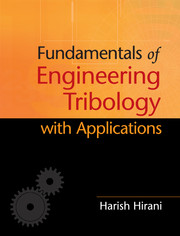Refine search
Actions for selected content:
8124 results in Fluid dynamics and solid mechanics
Appendix I - Direction Cosines as Functions of Orientation Angles
-
- Book:
- Dynamics
- Published online:
- 05 February 2016
- Print publication:
- 09 March 2016, pp 483-487
-
- Chapter
- Export citation
Frontmatter
-
- Book:
- Dynamics
- Published online:
- 05 February 2016
- Print publication:
- 09 March 2016, pp i-iv
-
- Chapter
- Export citation
Appendix III - Inertia Properties of Uniform Bodies
-
- Book:
- Dynamics
- Published online:
- 05 February 2016
- Print publication:
- 09 March 2016, pp 493-504
-
- Chapter
- Export citation
3 - Constraints
-
- Book:
- Dynamics
- Published online:
- 05 February 2016
- Print publication:
- 09 March 2016, pp 39-66
-
- Chapter
- Export citation
Index
-
- Book:
- Dynamics
- Published online:
- 05 February 2016
- Print publication:
- 09 March 2016, pp 505-511
-
- Chapter
- Export citation
9 - Extraction of Information from Equations of Motion
-
- Book:
- Dynamics
- Published online:
- 05 February 2016
- Print publication:
- 09 March 2016, pp 240-305
-
- Chapter
- Export citation
Preface to Dynamics: Theory and Applications
-
-
- Book:
- Dynamics
- Published online:
- 05 February 2016
- Print publication:
- 09 March 2016, pp xi-xiv
-
- Chapter
- Export citation
5 - Generalized Forces
-
- Book:
- Dynamics
- Published online:
- 05 February 2016
- Print publication:
- 09 March 2016, pp 100-133
-
- Chapter
- Export citation
Contents
-
- Book:
- Dynamics
- Published online:
- 05 February 2016
- Print publication:
- 09 March 2016, pp v-viii
-
- Chapter
- Export citation
6 - Constraint Forces, Constraint Torques
-
- Book:
- Dynamics
- Published online:
- 05 February 2016
- Print publication:
- 09 March 2016, pp 134-162
-
- Chapter
- Export citation
Problem Sets
-
- Book:
- Dynamics
- Published online:
- 05 February 2016
- Print publication:
- 09 March 2016, pp 353-482
-
- Chapter
- Export citation
8 - Formulation of Equations of Motion
-
- Book:
- Dynamics
- Published online:
- 05 February 2016
- Print publication:
- 09 March 2016, pp 191-239
-
- Chapter
- Export citation

Fundamentals of Engineering Tribology with Applications
-
- Published online:
- 05 March 2016
- Print publication:
- 11 March 2016
EDITORIAL: STOCHASTIC AND COMPUTATIONAL METHODS IN FINANCE
-
- Journal:
- The ANZIAM Journal / Volume 57 / Issue 3 / January 2016
- Published online by Cambridge University Press:
- 03 March 2016, pp. 205-206
-
- Article
-
- You have access
- Export citation
ANZ VOLUME 57 ISSUE 3 COVER AND BACK MATTER
-
- Journal:
- The ANZIAM Journal / Volume 57 / Issue 3 / January 2016
- Published online by Cambridge University Press:
- 03 March 2016, pp. b1-b7
-
- Article
-
- You have access
- Export citation
ANZ VOLUME 57 ISSUE 3 COVER AND FRONT MATTER
-
- Journal:
- The ANZIAM Journal / Volume 57 / Issue 3 / January 2016
- Published online by Cambridge University Press:
- 03 March 2016, pp. f1-f2
-
- Article
-
- You have access
- Export citation
BOUNDS ON PRICES FOR ASIAN OPTIONS VIAFOURIER METHODS
- Part of
-
- Journal:
- The ANZIAM Journal / Volume 57 / Issue 3 / January 2016
- Published online by Cambridge University Press:
- 19 February 2016, pp. 299-318
-
- Article
-
- You have access
- Export citation
HISTORICAL BACKTESTING OF LOCAL VOLATILITY MODEL USING AUD/USD VANILLA OPTIONS
- Part of
-
- Journal:
- The ANZIAM Journal / Volume 57 / Issue 3 / January 2016
- Published online by Cambridge University Press:
- 17 February 2016, pp. 319-338
-
- Article
-
- You have access
- Export citation
SIMULATION OF MULTI-ASSET OPTION GREEKS UNDER A SPECIAL LÉVY MODEL BY MALLIAVIN CALCULUS
- Part of
-
- Journal:
- The ANZIAM Journal / Volume 57 / Issue 3 / January 2016
- Published online by Cambridge University Press:
- 17 February 2016, pp. 280-298
-
- Article
-
- You have access
- Export citation
OPTIMAL PROPORTIONAL REINSURANCE AND INVESTMENT PROBLEM WITH CONSTRAINTS ON RISK CONTROL IN A GENERAL JUMP-DIFFUSION FINANCIAL MARKET
- Part of
-
- Journal:
- The ANZIAM Journal / Volume 57 / Issue 3 / January 2016
- Published online by Cambridge University Press:
- 17 February 2016, pp. 352-368
-
- Article
-
- You have access
- Export citation
